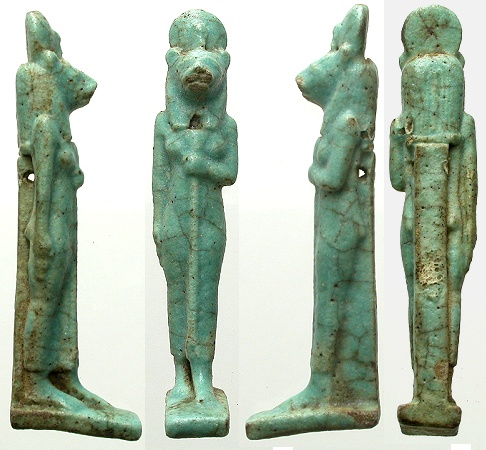

Nice Amulet of Sekhmet, XXII - XXVI Dynasty, c. 945 - 525 B.C.
Not the greatest ammy in the world, but a fairly nice example of the Late Middle Kingdom Period, just before the Greeks and Romans came in like locusts and blasted the area with their own cultural impositions, destroying all remnants of the craft of faience.
I have an XVIIIth Dynasty Sekhmet that is totally awesome, dated to North Palace at Akhet-Aten 1530 B.C., but it isn't for sale at any price; it's a School Artifact and even if it weren't, I would not put it up for public sale.
I posted this just to show what a fairly nice Sekhmet should look like, because several folks seem to be out there shopping.
Most of the pieces I've seen recently are from the workshops of several very clever forgers who flourished during the 1950s and 60s, notably Siddiq, the Gokhman brothers, James Edward Little, Cavino & Ligorio, and Geoffrey Bannister.
Mona Phillips, whom I knew well as a friend, was a notorious forger with a workshop in Los Angeles which reprocessed ancient materials into new works and "restorations" which were parts of different statuary, etc.; she had the best credentials -- she was the daughter of the former Chief of Antiquities at the Cairo Museum! There are many known forgers and even more unknown. Their work is very, very good and very, very deceptive even to the expert eye, and would certainly fool even the most wary of new buyers to the field.
Typically, the inexperienced shopper will get hurt a few times, then give up in despair; this is the real shame of forgeries, and the antiquities market is crammed with them. It is very easy to rework old terra-cotta, bronze, silver, gold and other materials to make new "antiquities" that pass every chemical and reagent test known to man!
This example of a Sekhmet amulet is real, but, well...it's really, really LATE for my taste, which runs to Middle Kingdom excluding the XIXth Dynasty of Ay and his co-conspirators who poisoned King Tut and restored the Priests of Amun-Ra as well as destroying any evidence of the great art and architecture of the Akhen-Aten/Nefertiti reigns.
See my dissertation written with Julia Samson for the Petrie Museum on the subject of Nefertiti's rule following the death of Akhen-Aten and on the Amarna faience glazing workshop. I have hundreds of examples of glaze-types in my personal collection; only by actually seeing and handling KNOWN examples with excavation history, as my examples are, directly from KNOWN published site records, can you hope to determine the reality of a faience piece.
Se Khmet amulet; cf. Lahun II, pl. 68, 1, RARE THUS, 6.3 cm (2 1/2") high, fine aquamarine faience; crazing demonstrates proper age and cannot be duplicated by forgery, although the back crusting can.
Absolutely guaranteed authentic and fairly hot psychometrically, with a lot of eye-appeal even though it is later than I'd like to see, and is somewhat worn and slightly damaged. It could be worse -- it could be Ptolomaic.
PRICE ON REQUEST
31155q00.jpg